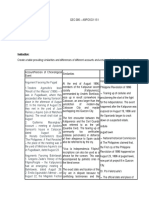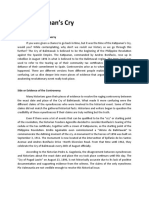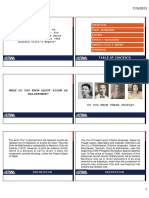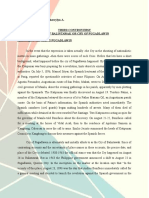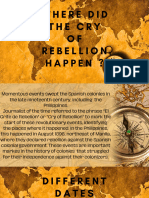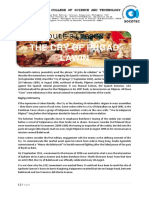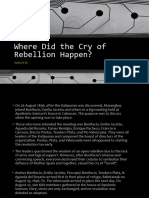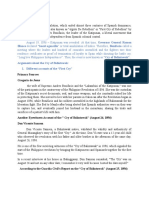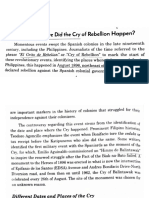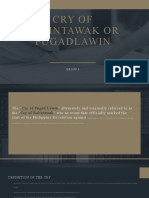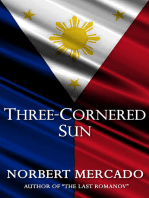Group-5 2
Uploaded by
Edmar BarredaGroup-5 2
Uploaded by
Edmar BarredaPUGAD
LAWIN,BALINTAWAK OR
BAHAY TORO
GROUP 5
PRESENTATION
Balintawak: The Cry for a Nationwide
Revolution
Milagros C, Guerrero, Emmanuel Encarnacion, Romon N.
Villegas June 06 2003
Nineteenth-century journalists used the phrase "el grito
de rebelion" or "the O of Rebellion" to describe the
momentous events sweeping the Spanish colonies in
Mexic it was the "Cry of Dolores (16 September 1820),
Brazil the "City of Ypiraga (7 September 1822), and in
Cuba the "Cry of Matanza" (24 February 1895) In
August 1896, northeast Manila, Filipinos similarly
declared their rebellion against the Spanish colun
government. It was Manuel Sastron, the Spanish
historian, who institutionalized the phrased for the
Philippines in his 1877 book, La Insurreccion en
Filipinas. All these "Crie were milestones in the several
colonial-to-nationalist histories of the world.
Cry of Pugadlawin
by Pio Valenzuela
The news of the discovery of the Katipunan spread throughout Manila and the suburbs.
Bonifacio, informed of the discovery, secretly instructed his runners to summon all the
leaders of the society to a general assembly to be held on August 24. They were to meet at
Balintawak to discuss the steps to be taken to meet the crisis. That same night of August 19,
Bonifacio, accompanied by his brother Procopio, Emilio Jacinto, Teodoro Plata, and Aguedo
del Rosario, slipped through the cordon of Spanish sentries and reached Balintawak before
midnight. Pio Valenzuela followed them the next day. On the 21st, Bonifacio changed the
Katipunan code because the Spanish authorities had already deciphered it. In the afternoon of
the same day, the rebels, numbering about 500, left Balintawak for Kangkong, where
Apolonio Samson, a Katipunero, gave them food and shelter. In the afternoon of August 22,
they proceeded to Pugadlawin. The following day, in the yard of Juan A. Ramos, the son of
Melchora Aquino who was later called the "Mother of the Katipunan," Bonifacio asked his
men whether they were prepared to fight to the bitter end. Despite the objection of his
brother-in-law, Teodoro Plata, all assembled agreed to fight to the last. "That being the case,"
Bonifacio said, "bring out your cedulas and tear them to pieces to symbolize our
determination to take up arms!" The men obediently tore up their cedulas, shouting "Long
live the Philippines!" This event marked the so called ‘cry of Balintawak’ which actually
happened in pugadlawin.
Cry of Balintawak
by Guillermo Masangkayin
The midst of this dramatic scene, some Katipuneros who had just arrived from Manila and Kalookan shouted
"Dong Andres! The civil guards are almost behind us, and will reconnoiter the mountains." Bonifacio at once ordered
his men to get ready for the expected attack of the Spaniards. Since they had inferior arms the rebels decided, instead,
to retreat. Under cover of darkness, the rebels marched towards Pasong Tamo, and the next day, August 24, they
arrived at the yard of Melchora Aquino, known as Tandang Sora It was decided that all the rebels in the surrounding
towns be notified of the general attack, on Manila on the night of August 29, 1896.
At ten in the morning of August 25, some women came rushing in and notified Bonifacio that the civil guards and
some infantrymen were coming. Soon after, a burst of fire came from the approaching Spaniards. The rebels
deployed and prepared for the enemy. In the skirmish that followed, the rebels lost two men and the enemy one.
Because of their inferior weapons, which consisted mostly of bolos and a few guns, the rebels decided to retreat. On
the other hand, the Spaniards, finding themselves greatly outnumbered, also decided to retreat. So, both camps
retreated and thus prevented a bloody encounter. This was the first skirmish fought in the struggle for national
emancipation.
On August 26, Spanish reinforcements were dispatched to Pasong Tamo to drive away the rebels. But the latter,
who were going to or were already in Balara, could not be found. The Spaniards, frustrated in their attempt to contact
the Filipino contingent, shot. instead, two innocent farmers who were leisurely going on their way home. Returning
to Manila, the Spanish soldiers boasted that a great fight has taken place at Pasong Tamo, and that they had driven
the rebels to the interior. This was the origin of the so-called "Cry of Balintawak," which neither happened on August
26 nor in Balintawak.
Different dates and places
An officer of the Spanish guardia
civil, Lt. Olegario Diaz, stated that
the Cry took place in Balintawak
on August 25, 1896
Historian Teodoro Kalaw in his 1925
book The Filipino Revolution wrote
that the event took place during the
last week of August 1896 at
Kangkong, Balintawak.
Historian Teodoro Agoncillo wrote
in 1956 that it took place in Pugad
Lawin on August 23, 1896, based
on Pio Valenzuela's statement.
Pío Valenzuela, a close associate of
Andres Bonifacio, declared in 1948
that it happened in Pugad Lawin on
August 23, 1896.
Historian Gregorio Zaide stated in his
books in 1954 that the "Cry"
happened in Balintawak on August
26, 1896
Santiago Alvarez, a Katipunero
and son of Mariano Alvarez, the
leader of the Magdiwang faction in
Cavite, stated in 1927 that the Cry
took place in Bahay Toro, now in
Quezon City on August 24, 1896.
RAGING CONTROVERSY
If the expression is taken literally-the Cry as the shouting of nationalistic slogans in mass assemblies then there
were scores of such Cries. Some writers refer to a Cry of Montalban on April 1895, in the Pamitinan Caves where
a group of Katipunan members wrote on the cave walls, "Viva la indepencia Filipina!" long before the Katipunan
decided to launch a nationwide revolution.
The historian Teodoro Agoncillo chose to emphasize Bonifacio's tearing of the cedula (tax receipt) before a
crowd of Katipuneros who then broke out in cheers. However, Guardia Civil Manuel Sityar never mentioned in his
memoirs (1896-1898) the tearing or inspection of the cedula, but did note the pacto de sangre (blood pact) mark on
every single Filipino he met in August 1896 on his reconnaissance missions around Balintawak.
On 3 September 1911, a monument to the Heroes of 1896 was erected in what is now the intersection of Epifanio
de los Santos Avenue (EDSA) and Andres Bonifacio Drive-North Diversion Road. From that time on until 1962,
the Cry of Balintawak was officially celebrated every 26 August.
It is not clear why the 1911 monument was erected there. It could not have been to mark the site of Apolonio
Samson's house in barrio Kangkong: Katipuneros marked that site on Kaingin Road, between Balintawak and San
Francisco del Monte Avenue.
Neither could the 1911 monument have been erected to mark the site of the first armed encounter which,
incidentally, the Katipuneros fought and won. A contemporary map of 1896 shows that the August battle between
the Katipunan rebels and the Spanish forces led by Lt. Ros of the Civil Guards took place at sitio Banlat, North of
Pasong Tamo Road far from Balintawak. The site has its own marker.
CONFLICTING ACCOUNTS
Pio Valenzuela had multiple versions of the Cry of the Revolution, with
conflicting accounts arising. Valenzuela claimed that Katipunan meetings
took place between 23 and 25 August in Balintawak, while the Cry occurred
on 23 August at Apolonio Samson's house in Balintawak. From 1928 to 1940,
Valenzuela claimed the Cry occurred at Tandang Sora's house in Pugad
Lawin. In 1935, Valenzuela, Pantas, and Pacheco proclaimed that the first Cry
of the revolution did not happen in Balintawak, but in Pugad Lawin. In 1940,
the Philippines Historical Committee identified Pugad Lawin as part of sitio
Gulod, Banlat, Kalookan City. In 1963, President Diosdado Macapagal
ordered the Cry to be celebrated on 23 August and Pugad Lawin as its site.
THE PUGAD LAWIN MARKER
The prevalent account of the Cry is that of Teodoro Agoncillo in Revolt of the
masses (1956): It was in Pugad Lawin, where they proceeded upon leaving
Samson's place in the afternoon of the 22nd, that the more than 1,000 members of
the Katipunan met in the yard of Juan A. Ramos, son of Melchora Aquino, in the
morning of August 23rd. Considerable discussion arose whether the revolt against
the Spanish government should be started on the 29th. Only one man protested...
But he was overruled in his stand.... Bonifacio then announced the decision and
shouted: "Brothers, it was agreed to continue with the plan of revolt. My brothers,
do you swear to repudiate the government that oppresses us?" And the rebels,
shouting as one man replied: "Yes, sir!" "That being the case," Bonifacio added,
"bring out your cedulas and tear them to pieces to symbolize our determination to
take arms!". Amidst the ceremony, the rebels, tear-stained eyes, shouted: "Long
live the Philippines! Long live the Katipunan!
Consequently, Diosdado Macapagal ordered that the Cry of Balintawak be
called the "Cry of Pugad Lawin, and that it be celebrated on 23 August instead of
26 August. The 1911 monument in Balintawak was later removed to a highway.
Student groups moved to save the discarded monument, and it was installed in
front of Vinzons Hall in the Diliman campus of the University of the Philippines
on 29 November 1968.
Ang Sigaw ng Pugad Lawin(1896)
Sa paligid ng pook na ito, si Andres Bonifacio at mga isang libong
Katipunero at nagpulong noong umaga ng ika-23 Agosto 1896, at ipinasyang
mag himagsik laban sa Kastila sa Pilipinas.Bilang patunay ay pinag-pupunit
ang kanilang mga sedula na naging tanda ng pagkaalipin ng mgaPilpino. Ito
ang kaunaunahang sigaw ng Bayang Api laban sa bansang Espanya na
pinatibayan sa pamamagitan ng paggamit ng sandata.
(On this site Andres Bonifacio and one thousand Katipuneros met in the
morning of 23 August 1896 and decided to revolt against the Spanish colonial
government in the Philippines. As an affirmation of their resolve, they tore up
their tax receipts which were symbols of oppression of the Filipinos. This was
very first Cry of the Oppressed Nation against Spain which was enforced with
use of arms.)
The place name "Pugad Lawin". however, is problematic. In History of the
Katipunan (1939). Zaide records Valenzuela's mention of the site in a footnote
and not in the body of text, suggesting that the Historian regarded the matter as
unresolved.
Cartographic Changes
A rough sketch or croquis de las operaciones practicadas in El Español showed the movements of Lt. Ros against the
Katipunan on 25, 26, and 27 August 1896. The map defined each place name as sitio "Baclac" (sic: Banlat). In 1897, the
Spanish historian Sastron mentioned Kalookan, Balintawak, Banlat and Pasong Tamo. The names mentioned in some
revolutionary sources and interpretations-Daang Malalim, Kangkong and Pugad Lawin- were not identified as barrios.
Even detailed Spanish and American maps mark only Kalookan and Balintawak.
In 1943 map of Manila marks Balintawak separatelt from Kalookan and Diliman. The sites where revolutionary events
took place are within the ambit of Balintawak. Government maps issued in 1956, 1987, and 1990, confirm the existence of
barangays Bahay Toro, but do not define their boundaries. Pugad Lawn is not on any of these maps.
Writer and linguist Sofronio Calderon, conducting research in the late 1920s on the toponym "Pugad Lawin," went
through the municipal records and the Census of 1903 and 1918, could not find the name, and concluded that Isang
pagkakamali and sabihing mayroong Pugad Lawin sa Kalookan. "(It would be a mistake to say that there is such as Paugad
Lawin in Kalookan).
First, that "Pugad Lawin" was never officially recognized as a place name on any Philippine map before Second World
War. Second, "Pugad Lawin" appeared in historiography only from 1928, or some 32 years after the events took place. And
third, the revolution was always traditionally held to have occurred in the area of Balintawak, which was distinct from
Kalookan and Diliman Therefore, while the toponym "Pugad Lawin" is more romantic, it is more accurate to stick to the
original "Cry of Balintawak.
Determining the Date
The later accounts of Pio Valenzuela and Guillermo Masangkay on the tearing o
cedulas on 23 August are basically in agreement, but conflict with each other on the
location. Valenzuela points to the house of Juan Ramos in Pugad Lawin, while
Masangkay refers to Apolonio Samson's in Kangkong. Masangkay's final statement
has more weight as it was corroborated by many eyewitnesses who were
photographed in 1917, when the earliest 23 August marker was installed. Valenzuela's
date (23 August) in his memoin conflict with 1928 and 1930 photographs of the
surveys with several Katipunan officers published in La Opinion, which claim that the
Cry took place on the 24th.
THE TURNING POINT
What occurred during those last days of August 1896? Eyewitness
accounts mention captures, escapes, recaptures, killings of Katipunan
members; the interrogation of Chinese spies; the arrival of arms in
Meycauyan, Bulacan; the debate with Teodoro Plata and others; the
decision to go war; the shouting of slogan; tearing of cedulas; the
sending of letters presidents of Sanggunian and balangay councils; the
arrival of civil guard; the loss of Katipunan funds during the battle. All
these events, and many others, constitute the beginning of nationwide
revolution.
The Cry, however, must be defined as that turning point when the
Filipinos finally rejected Spanish colonial dominion over the
Philippine Islands, by formally constituting their own national
government, and by investing a set of leaders with authority to initiate
and guide the revolution towards the establishment of sovereign
nation.
Thank
you
You might also like
- Historical Controversy: Cry of Balintawak or Cry of Pugadlawin?No ratings yetHistorical Controversy: Cry of Balintawak or Cry of Pugadlawin?6 pages
- Gec 102 Activity 6 The Cry of Pugad LawinNo ratings yetGec 102 Activity 6 The Cry of Pugad Lawin5 pages
- Where Did The Cry of - 20231130 - 230559 - 0000No ratings yetWhere Did The Cry of - 20231130 - 230559 - 000017 pages
- CHAPTER 10 - The Cry Pugadlawin, Balintawak or Bahay ToroNo ratings yetCHAPTER 10 - The Cry Pugadlawin, Balintawak or Bahay Toro54 pages
- The Cry of Pugad Lawin: Module 3 Lesson 4No ratings yetThe Cry of Pugad Lawin: Module 3 Lesson 48 pages
- Position Paper Final Sigaw NG Pugad Lawin PDF FreeNo ratings yetPosition Paper Final Sigaw NG Pugad Lawin PDF Free3 pages
- Position Paper Final Sigaw NG Pugad Lawin PDF FreeNo ratings yetPosition Paper Final Sigaw NG Pugad Lawin PDF Free3 pages
- Where-Did-the-Cry-of-Rebellion-Happen (Autosaved)No ratings yetWhere-Did-the-Cry-of-Rebellion-Happen (Autosaved)13 pages
- Balintawak - The Cry For A Nationwide RevolutionNo ratings yetBalintawak - The Cry For A Nationwide Revolution8 pages
- Blanco Declared "Huest Agoncillo" or Total Annihilation of Indios. Therefore, Bonifacio Called ANo ratings yetBlanco Declared "Huest Agoncillo" or Total Annihilation of Indios. Therefore, Bonifacio Called A4 pages
- Cry of Balintawak or Pugad Lawin - Group 4 Presentation100% (11)Cry of Balintawak or Pugad Lawin - Group 4 Presentation12 pages
- Visions of Power in Cuba: Revolution, Redemption, and Resistance, 1959-1971From EverandVisions of Power in Cuba: Revolution, Redemption, and Resistance, 1959-19713/5 (1)
- The Making of The National Movement Worksheet 2No ratings yetThe Making of The National Movement Worksheet 22 pages
- UPSC Prelims 2024 - : Exam Title Email ContactNo ratings yetUPSC Prelims 2024 - : Exam Title Email Contact38 pages
- L33 Modern History Revolutionary Nationalism Part 1 Anushilan SamitiNo ratings yetL33 Modern History Revolutionary Nationalism Part 1 Anushilan Samiti67 pages
- Modern History Schedule - GS Foundation 2026_49984102_2025_03_07_18_04No ratings yetModern History Schedule - GS Foundation 2026_49984102_2025_03_07_18_044 pages
- Books On and by Chittaranjan Das (English Books) : SL - No Title Author Publisher Year of PublicationNo ratings yetBooks On and by Chittaranjan Das (English Books) : SL - No Title Author Publisher Year of Publication2 pages
- Subhas Chandra Bose and The Alternative Politics inNo ratings yetSubhas Chandra Bose and The Alternative Politics in32 pages
- Indian National Movements Modern History PYQ 1995 2020No ratings yetIndian National Movements Modern History PYQ 1995 202064 pages
- Topic To Be Discussed: Early Uprising Against British RuleNo ratings yetTopic To Be Discussed: Early Uprising Against British Rule2 pages
- Static General Knowledge - Indian National MovementNo ratings yetStatic General Knowledge - Indian National Movement2 pages
- Ilide.info Claims of Balintawak Different Dates and Places Pr 209f0e991c6be8f1ed445c2932682cccNo ratings yetIlide.info Claims of Balintawak Different Dates and Places Pr 209f0e991c6be8f1ed445c2932682ccc3 pages
- Nationalism in India Notes Class 10 HistoryNo ratings yetNationalism in India Notes Class 10 History9 pages



